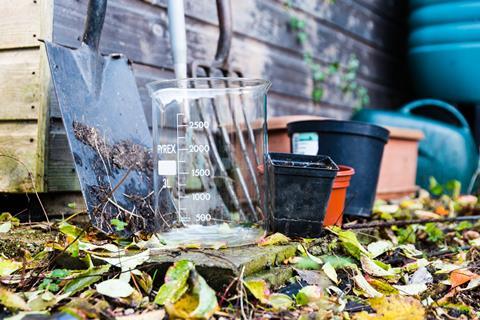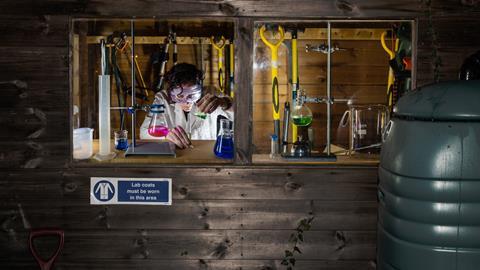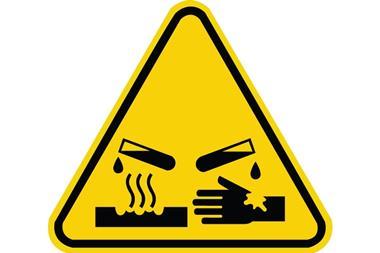Is doing chemistry at home possible today? Sarah Houlton finds out
Hobby chemistry has a rich history. In the past it was not uncommon for people to do experiments at home, and the first synthetic dye, mauveine, was the result of a gone-wrong attempt to make quinine in a home lab by an 18-year-old William Henry Perkin in the 1850s. But these days, hobby chemistry has something of a bad reputation, and there is a general consensus that home chemists must be up to no good.
‘A century ago, if you had a laboratory at home you weren’t a terrorist or making drugs, you were an innovator – someone who was exceptional in the pursuit of knowledge,’ says Lou Britton, who started doing chemistry at home in the US state of Ohio at the age of 13. ‘We’ve gone from creators to destroyers, and chemistry has been villainised.’
It doesn’t help that chemistry sets have been heavily neutered in recent years. In the 1950s and 1960s, all manner of toxic chemicals, heavy metals and even nuclear isotopes featured in the kits sold in toy stores (see All set for chemistry). ‘Today, you might get vinegar, baking soda and, if you’re lucky, some alum to grow crystals with. That’s about it,’ Britton says.
Pocket money to platinum
Britton started his first home lab with simple glassware, learning about acids, bases and titrations, and then combined it with his interests in metal casting. He and a friend joined forces, and set up a lab in the friend’s basement. ‘We had a fume hood, we built a tube furnace, and we had a very nice analytical balance,’ he says.
They constructed a lab bench, and placed the balance on an offcut of granite from his mother’s new kitchen counter (required after a less-than-successful attempt to isolate zinc from pennies burned a hole in her Formica countertop). They even had a fractionating column that was eight feet (2.4m) tall.
The pair would source scrap metal, from lead wheel weights to platinum electrodes, and sell it on, often after processing it, and reinvest the money they made in additional lab equipment. ‘It was a self-financing hobby,’ he says.

Robert Vincent became fascinated with chemistry while growing up in the suburbs of Detroit, US. ‘I saw acids being used to dissolve things on TV, and my mind was blown away,’ he says. ‘I thought the acid blood in the movie Alien was really cool. But when I got into middle school and started studying chemistry there weren’t really any labs. The books were written to make it sound interesting, with lots of colours and fire, so I took my books, and did what I could at home. I’d see something in the store, look for something to do with it, and then try it and see what happened.’ He also tried to repeat historical experiments, such as using a retort to isolate phosphorus.
Hobby chemists have gone from creators to destroyers, and chemistry has been villainised
Now in his early 40s, Philippe Louis has been doing chemistry at home in Brussels in Belgium since he was 13. ‘I got a chemistry set when I was eight, but was too young then to understand the experiments described in the manual,’ he says. ‘I enjoyed mixing things together, and observing the effect – especially when it was spectacular, whether that was a smell, foaming, or a colour change. Chemistry lessons at school helped me understand the experiments, too.’
His interest was piqued further by studying old chemistry books of his mother’s, having failed exams after a dose of influenza caused him to miss science lessons essential for the tests. ‘At first, I read the chapters that interested me the most, then I found everything quite logical and read all the rest,’ he says. ‘I wanted to learn more, and bought chemistry books with my pocket money. I got nearly full marks on my next chemistry exam, and decided I wanted to study chemistry.’
Louis initially did his experiments in the basement and terrace of his mother’s apartment and in the garden of his father’s house. His chemistry is now done in the garage, and outdoors away from inhabited areas for fireworks, pyrotechnics and energetic materials. He still does a wide range of experiments on top of the pyrotechnics – from perfumes and crystal growing to fermentation, making dyes and even the synthesis of as-yet unmade organic molecules.
The good, the bad and the… others
Louis’s experimental highlights include buying glass distillation equipment and using it to distil fermented fruit juices (‘That was a good Christmas holiday!’ he says), his exploits in pyrotechnics, and the mononitration of toluene with medium-concentrated nitric acid – an experiment the textbooks told him would not work. He also remembers his university presentation on explosives and powders fondly. ‘We had an agreement with the security people and a safety perimeter with metal fences around the outdoor experiment site,’ he says. ‘Chemistry teachers were very pleased as chemistry has become so boring at school thanks to European regulations.’

Britton carried out a 36-hour fractional distillation of gasoline. ‘We wanted to see what was in it, and collected about 80 different fractions, including benzene, toluene and xylene,’ he says. ‘There was still a residue on the bottom that didn’t boil that we assumed was some sort of fuel preservative.’
Of course, there have been mishaps. Louis says he learned from the mistakes he made in his younger days, ranging from generating more chlorine gas than expected to burning the bedroom carpet and dyeing patches of the ceiling yellow with a trinitrophenol dye.
Vincent’s worst accident involved an attempt, in his early teens, to precipitate silver that fused a Kevlar glove to his hand. ‘The ER doctor kept asking me what chemicals I’d got on it, but of course it was just very, very hot – a thermal burn, not a chemical burn,’ he says. There was also an incident where he was trying to isolate potassium via hydrolysis of molten potassium hydroxide, and the epoxy holding his cell together melted. He threw it all into a large bucket of water, and it frothed all over the lawn. ‘The grass grew back dark green. It was just beautiful.’
The one accident Britton had was when making Mn2 O7 using Brauer’s Handbook of preparative inorganic chemistry. ‘It was a hot and humid day, and maybe we didn’t clean something properly, but the whole thing exploded on us,’ he says. ‘A piece landed on my friend, and he rushed straight into the shower. That’s when we said we were done with this type of thing.’
Scaring the neighbours?
Perhaps the best way to head off negative criticism is to be open about what’s being done. Vincent says the neighbours knew what he was doing, and he talked to them about chemistry. ‘They didn’t mind as long as they didn’t smell anything,’ he says. ‘I didn’t work with pyrophorics or explosives, and I don’t think that would have been compatible with living in a closely packed neighbourhood. My phosphorus experiments were done at my grandfather’s house out in the countryside. Anything I did at home was pretty benign – I always figured that if I needed to wear a gasmask I shouldn’t be doing it in the backyard, as my neighbours weren’t wearing gasmasks!’

Britton once had a visit from the FBI, after some mercury he’d bought leaked in transit. ‘Two special agents knocked on the door, and I told them I’d been expecting them as they might think I was making tilting switches for bombs,’ he says. ‘It was for the mercury diffusion pump, which I was using to grow gold, platinum and palladium crystals. They both had technical backgrounds and said that it made perfect sense, and I never had another issue with them.’
Openness is a polarising opinion among hobby chemists. ‘A lot of people have an innate distrust of the authorities,’ Britton says. ‘There is historical precedent – look at those who were burnt at the stake for practising rudimentary medicine that people thought was witchcraft. But when things go wrong, it’s so often a failure to communicate. Yes, there are people who are irresponsible and have no concern for safety, but the majority are responsible. There are plenty of amateur chemists who follow the letter of the law as far as chemical storage and how they dispose of their waste.’
Sourcing supplies
Although regulations now limit what individuals are able to buy, many common chemicals are easily sourced from normal stores. Some are obvious, and the hardware store is a good starting point. Acetone is in paint thinners, sodium hydroxide is the main ingredient in many oven cleaners and drain unblocking products, road salt often contains calcium chloride, and sodium hypochlorite and hydrogen peroxide are found in bleach products.
Pool supply stores are also a rich source of reagents too, including potassium permanganate and hydrochloric acid. And, of course, chemicals such as sodium chloride, acetic acid and sodium hydrogencarbonate are easy to find nestling among the food products at the supermarket. Others require a little creativity in isolation and transformation. Sodium nitrate stump remover can be used to make nitric acid, for example, and ether can be isolated from lawnmower starter fluid.
Other chemicals can be trickier to source. One company that sells chemicals to home chemists is Michigan-based United Nuclear. It’s run by Bob Lazar, who says that back when he was a kid in the 1960s and 70s, neighbourhood hobby stores sold chemicals and glassware, but that has changed. He set up the company in the late 1990s to fill that gap.
Lazar says there is a fine line to walk in terms of legal issues. ‘Some materials can only be sold by the manufacturer, so although we sell them they are actually shipped from somewhere else,’ he says. But, perhaps surprisingly, things like radioactive uranium ore are not regulated in the US at all as they are deemed natural.
His biggest seller, he says, is neodymium magnets, followed by chemicals, tools and equipment. ‘Another big product is a glow-in-the-dark powder that can be used to make paint or nail polish,’ he says. ‘We have a whole range of radioactive isotopes. In the US, under a certain amount they aren’t regulated as long as they are sealed in solid plastic discs, or they can’t be eaten, or aren’t radioactive enough to cause any harm.’
Gert Meyers’s company Oxford ChemServe, based in Bridlington in the UK, supplies chemicals to hobbyists. He says the biggest problem home chemists face in sourcing supplies is gaining access to restricted chemicals. ‘The list is ever-increasing,’ he says. ‘What was over-the-counter as little as 10 years ago can now be hard to buy without the relevant licences.’
Meyers’ activities in the area started as a hobby, but he has been running a small part-time business for the past five years. About 95% of his sales are to individuals. He says that the cheaper products sell best, with ‘exotics’ fetching much higher margins but lower volumes.
Regulations do need to be tight, Lazar believes. ‘We certainly wouldn’t want to start selling something that became a component of something that might hurt someone,’ he says. But the authorities do not always make sensible decisions. ‘I can’t sell flasks or beakers in Texas because in raids on clandestine methamphetamine labs, the police kept seeing flasks and thought they were needed to make methamphetamines. So the authorities decided to make them illegal. Yet you can make methamphetamine in a pickle jar. You need qualified people to make these decisions, and that’s not always the case.’
From home lab to career
Vincent and Britton both now work as chemists in industry. Britton turned his hobby into a business at the end of his degree, based on the metalwork he’d been doing to earn money in his spare time, instead of taking up a place at graduate school. He wrote a business plan, got investment backing, and at the end of 2010 the company was born. It’s now a multi-million dollar business.

Vincent has been a process chemist at SAFC in Sheboygan, Wisconsin, for a decade, which has allowed him to broaden his chemistry horizons. He was a phosgene chemist for four years, then spent a couple of years making organometallic precursors, then a year of scale-up chemistry, and is now a flow chemist. ‘My first large-scale reaction involved the condensation of 45.5kg of phosgene into a 72-litre round-bottomed flask – not the sort of thing you would do at home!’ he says.
His home chemistry is now limited to the odd bit of electroplating, and although he would love to do more, a year working in hazardous waste disposal gave him a keen sense of the liabilities involved. ‘There was a clause in my mortgage contract that said I wouldn’t have any non-essential hazardous materials in my home,’ he says.
Words from the wise
Britton says it is important to keep a laboratory notebook and plan experiments properly – including having a response plan in case of accident. ‘Very rarely did we go into something unprepared, and we would talk about what could happen,’ he says. ‘But the authorities are used to seeing irresponsible people doing irresponsible things, and that’s where things get demonised in the media. These are the people who are ruining the hobby, setting back science, and clipping the wings of innovators to come.’
His advice to those wanting to do chemistry at home is not to say anything more than you have to, but don’t act like you have something to hide. ‘Don’t skimp on safety or put waste down the drain,’ he says. ‘Don’t damage the reputation of the hobby for everyone else. It is possible to pursue your interests in a responsible fashion. If the police or fire department visit and you can show them the precautions you take, I’m willing to bet they will let you be.’
You have to think twice before experimenting in case of mishaps, and it is best to work in small quantities because of safety concerns
Louis says that a well-designed home lab space is essential, with venting, a fume hood, a sink, and of course fire-fighting and first aid equipment. ‘You have to think twice before experimenting in case of mishaps, and it is best to work in small quantities because of safety concerns, for both yourself and your neighbours. And a non-chemophobic girlfriend helps!’
Vincent would definitely encourage people interested in home chemistry to go for it, as it helped him become a better chemist. ‘There are many things you can do in a small, confined space, such as crystal growing and electroplating,’ he says. ‘I wouldn’t recommend making pyrotechnic compositions or sparklers; I was never interested in doing that as I was afraid something bad could happen and the risk that posed to the people around me.’
Britton’s desire to do chemistry remains. ‘It’s been a long road for me, from amateur science to doing it professionally. Even though I have a laboratory at work, with fume hoods, epoxy floors and instruments, I still want another laboratory at home.’
Sarah Houlton is a science writer based in Boston, US













2 readers' comments